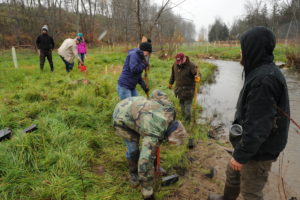Elk Creek Restoration Project Highlights Future of Chesapeake Conservation
 Annapolis, MD – Chesapeake Conservancy recently joined partners to install vegetation and structures to reduce nutrient and sediment runoff and improve water quality on a property on Elk Creek, a tributary of Penns Creek, in Centre County, PA. On-the-ground partners for the project included the U.S. Fish and Wildlife Service, Habitat Forever, the Foundation for California University of Pennsylvania, Penns Valley Conservation Association, Seven Willows LLC, USDA Natural Resources Conservation Service, and the Chesapeake Bay Foundation. Funding for the project was provided by USDA’s Natural Resources Conservation Service, Pennsylvania DEP Growing Greener and Glen’s Garden Market, and Winghaven Nursery donated nursery stock.
Annapolis, MD – Chesapeake Conservancy recently joined partners to install vegetation and structures to reduce nutrient and sediment runoff and improve water quality on a property on Elk Creek, a tributary of Penns Creek, in Centre County, PA. On-the-ground partners for the project included the U.S. Fish and Wildlife Service, Habitat Forever, the Foundation for California University of Pennsylvania, Penns Valley Conservation Association, Seven Willows LLC, USDA Natural Resources Conservation Service, and the Chesapeake Bay Foundation. Funding for the project was provided by USDA’s Natural Resources Conservation Service, Pennsylvania DEP Growing Greener and Glen’s Garden Market, and Winghaven Nursery donated nursery stock.
The partners planted a 35-foot wide riparian buffer along a 1000-foot agriculturally impaired stretch of the stream. This is one of six sites that are part of a new mapping validation project to identify where restoration can have the greatest benefits to water quality and wildlife habitat.
“Through this project, Chesapeake Conservancy and our partners are using precision conservation—projects at the right place, the right scale, the right size, the right time, and making sure they are working—to pilot a new approach to conservation. Instead of sweeping acquisitions or all-encompassing legislation, we can use the latest high-resolution datasets to conduct advanced geospatial analysis to better target and implement best management practices,” Chesapeake Conservancy President and CEO Joel Dunn said.
An analysis done by the Chesapeake Conservancy determined that this one acre riparian restoration area has the potential to intercept and mitigate runoff from nearly 14 acres of upstream farmland, lawns, impervious surfaces, such as roadways and sidewalks. Mapping the relationship between upslope land and the creek receiving runoff can help identify priority areas where restoration can keep pollutants from entering local waterways and the Susquehanna River.
“Precision conservation is one of the most exciting new concepts that I have been involved with in my twenty year career in conservation. With its data-driven tools, it truly has the potential to reshape how we approach, plan, and restore streams in Pennsylvania and beyond,” Frank Rohrer, restoration specialist, Chesapeake Bay Foundation, said. “Just as importantly it creates new partnerships with landowners and organizations, enabling us to get projects on the ground where they are needed the most.”
Chesapeake Conservancy has financially supported this project through a partnership with the Washington, D.C.-based Glen’s Garden Market. To balance the carbon footprint of shipping products from outside the Chesapeake Bay watershed to their grocery stores, Glen’s Garden Market provided funding for the riparian planting.
The planting includes a diverse mix of high-value wildlife food and cover including shrub, tree, and pollinator forb species. “We are taking a holistic, multifaceted approach to stream restoration in Penns Valley and elsewhere in the Bay watershed,” Lysle Sherwin said. Mr. Sherwin is the principal of Seven Willows LLC and affiliate biologist with the USFWS Partners for Fish and Wildlife program. Earlier this year, additional best management practices (BMPs) were implemented to control invasive exotic plants, exclude livestock from the stream, provide habitat for trout, and prevent future erosion and sedimentation.
Chip Brown and Jonathan King own properties along this section of Elk Creek. Brown and King are both optimistic about the in-stream and riparian projects and look forward to continuing to work with all the groups that have made this project possible. “I believe this project will definitely help to stabilize the banks from eroding and increase habitat for the fish in Elk Creek,” King said.
“The stream work has already improved the rate of flow in the stream in our property and helps to keep sediment off the stream bottom,” Brown said. “I have already spoken to other neighboring streamside landowners about conservation projects. In order for the project to be successful, educating other neighboring streamside landowners will be critical.”
Currently, 21 Penns Valley landowners are participating in stream restoration and habitat buffer projects on five waterways sponsored by Penns Valley Conservation Association and numerous partners.
New Mapping Validation Project
The Chesapeake Conservancy has coordinated with local universities to monitor this location and validate the mapping methodology. In May before the BMPs were installed, four researchers and 15 students began monitoring this and five other study sites. The research team will continue to monitor water chemistry, algae, fish, and macroinvertebrates at these sites in the ensuing years. Research findings will help validate and refine the mapping tools in order to create a model to use throughout the Susquehanna River watershed, which will ultimately benefit the Chesapeake Bay. Project partners include Chesapeake Conservancy, Pennsylvania Department of Conservation and Natural Resources, Chesapeake Bay Foundation, Foundation for Pennsylvania Watersheds, Degenstein Foundation, Susquehanna University, and Bloomsburg University. The project is funded by the National Fish and Wildlife Foundation Innovative Nutrient and Sediment Reduction program.
This material is based on work supported by the U.S. Environmental Protection Agency and the Chesapeake Bay Program’s Innovative Nutrient and Sediment Reduction grants program, which support efforts within the Chesapeake Bay watershed to accelerate nutrient and sediment reductions with innovative, sustainable, and cost-effective approaches.